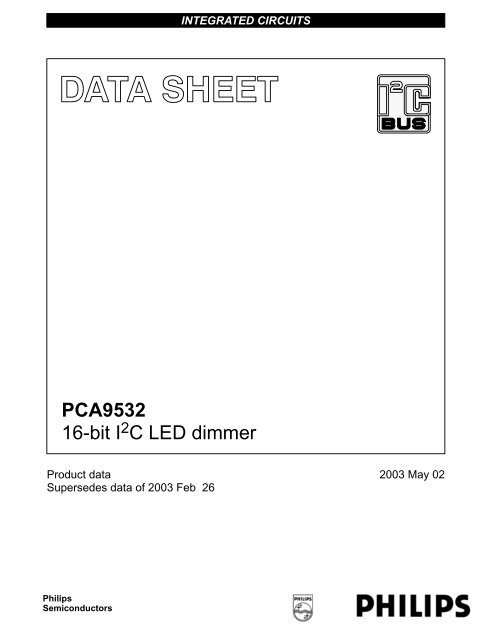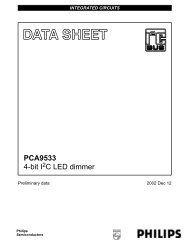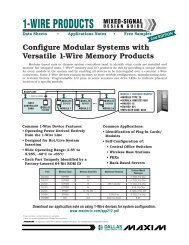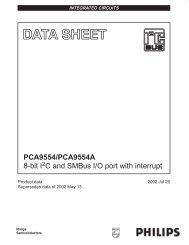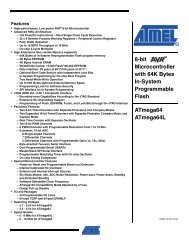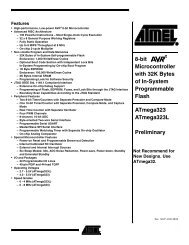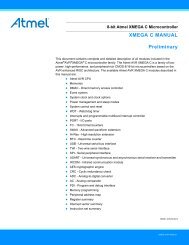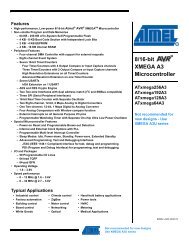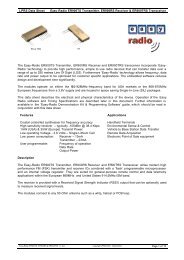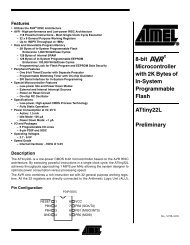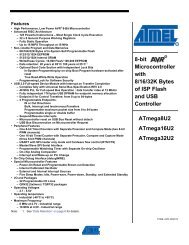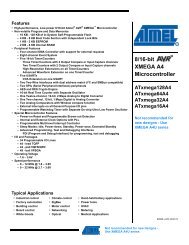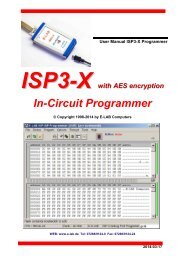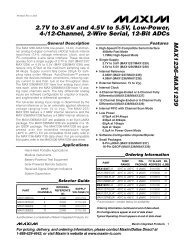PCA9532 16-bit I C LED dimmer - E-LAB Computers
PCA9532 16-bit I C LED dimmer - E-LAB Computers
PCA9532 16-bit I C LED dimmer - E-LAB Computers
You also want an ePaper? Increase the reach of your titles
YUMPU automatically turns print PDFs into web optimized ePapers that Google loves.
INTEGRATED CIRCUITS<strong>PCA9532</strong><strong>16</strong>-<strong>bit</strong> I 2 C <strong>LED</strong> <strong>dimmer</strong>Product dataSupersedes data of 2003 Feb 262003 May 02PhilipsSemiconductors
Philips SemiconductorsProduct data<strong>16</strong>-<strong>bit</strong> I 2 C <strong>LED</strong> <strong>dimmer</strong><strong>PCA9532</strong>DESCRIPTIONThe <strong>PCA9532</strong> is a <strong>16</strong>-<strong>bit</strong> I 2 C-bus and SMBus I/O expanderoptimized for dimming <strong>LED</strong>s in 256 discrete steps forRed/Green/Blue (RGB) color mixing and back light applications.FEATURES• <strong>16</strong> <strong>LED</strong> drivers (on, off, flashing at a programmable rate)• 2 selectable, fully programmable blink rates (frequency and dutycycle) between 0.625 and <strong>16</strong>0 Hz (6.4 seconds and6.25 milliseconds)• 256 brightness steps• Input/outputs not used as <strong>LED</strong> drivers can be used as regularGPIOs• Internal oscillator requires no external components• I 2 C-bus interface logic compatible with SMBus• Internal power-on reset• Noise filter on SCL/SDA inputs• Active-LOW reset input• <strong>16</strong> open drain outputs directly drive <strong>LED</strong>s to 25 mA• Controlled edge rates to minimize ground bounce• No glitch on power-up• Supports hot insertion• Low stand-by current• Operating power supply voltage range of 2.3 V to 5.5 V• 0 to 400 kHz clock frequency• ESD protection exceeds 2000 V HBM per JESD22-A114,150 V MM per JESD22-A115 and 1000 V CDM per JESD22-C101• Latch-up testing is done to JEDEC Standard JESD78 whichexceeds 100 mA• Packages offered: SO24, TSSOP24, HVQFN24The <strong>PCA9532</strong> contains an internal oscillator with two userprogrammable blink rates and duty cycles coupled to the outputPWM. The <strong>LED</strong> brightness is controlled by setting the blink rate highenough (> 100 Hz) that the blinking cannot be seen and then usingthe duty cycle to vary the amount of time the <strong>LED</strong> is on and thus theaverage current through the <strong>LED</strong>.The initial set-up sequence programs the two blink rates/duty cyclesfor each individual PWM. From then on, only one command from thebus master is required to turn individual <strong>LED</strong>s ON, OFF, BLINKRATE 1 or BLINK RATE 2. Based on the programmed frequencyand duty cycle, BLINK RATE 1 and BLINK RATE 2 will cause the<strong>LED</strong>s to appear at a different brightness or blink at periods up to1.6 seconds. The open drain outputs directly drive the <strong>LED</strong>s withmaximum output sink current of 25 mA per <strong>bit</strong> and 200 mA perpackage (100 mA per octal).To blink <strong>LED</strong>s at periods greater than 1.6 seconds the bus master(MCU, MPU, DSP, chipset, etc.) must send repeated commands toturn the <strong>LED</strong> on and off as is currently done when using normal I/OExpanders like the Philips PCF8575 or PCA9555. Any <strong>bit</strong>s not usedfor controlling the <strong>LED</strong>s can be used for General Purpose ParallelInput/Output (GPIO) expansion which provides a simple solutionwhen additional I/O is needed for ACPI power switches, sensors,pushbuttons, alarm monitoring, fans, etc.The active-LOW hardware reset pin (RESET) and Power-On Reset(POR) initializes the registers to their default state, all zeroes,causing the <strong>bit</strong>s to be set HIGH (<strong>LED</strong> off).Three hardware address pins on the <strong>PCA9532</strong> allow eight devicesto operate on the same bus.ORDERING INFORMATIONPACKAGES TEMPERATURE RANGE ORDER CODE TOPSIDE MARK DRAWING NUMBER24-pin plastic SO -40 to +85 °C <strong>PCA9532</strong>D <strong>PCA9532</strong>D SOT137-124-pin plastic TSSOP -40 to +85 °C <strong>PCA9532</strong>PW <strong>PCA9532</strong> SOT355-124-pin plastic HVQFN -40 to +85 °C <strong>PCA9532</strong>BS 9532 SOT6<strong>16</strong>-1Standard packing quantities and other packaging data is available at www.philipslogic.com/packaging.I 2 C is a trademark of Philips Semiconductors Corporation.2003 May 022
Philips Semiconductors<strong>16</strong>-<strong>bit</strong> I 2 C <strong>LED</strong> <strong>dimmer</strong>Product data<strong>PCA9532</strong>PIN CONFIGURATION — SO, TSSOPPIN CONFIGURATION — HVQFNA0 124 V DDA1A2<strong>LED</strong>0<strong>LED</strong>1<strong>LED</strong>2<strong>LED</strong>3<strong>LED</strong>4<strong>LED</strong>5<strong>LED</strong>6<strong>LED</strong>7V SS2345678910111223222120191817<strong>16</strong>151413SDASCLRESET<strong>LED</strong>15<strong>LED</strong>14<strong>LED</strong>13<strong>LED</strong>12<strong>LED</strong>11<strong>LED</strong>10<strong>LED</strong>9<strong>LED</strong>8SW00931Figure 1. Pin configuration — SO, TSSOP<strong>LED</strong>0 1<strong>LED</strong>1 2<strong>LED</strong>2 3<strong>LED</strong>3 4<strong>LED</strong>4 5A2A1A0V DDSDASCL2423222120789101118 RESET17 <strong>LED</strong>15<strong>16</strong> <strong>LED</strong>1415 <strong>LED</strong>1314 <strong>LED</strong>12TOP VIEWsu0<strong>16</strong>68Figure 2. Pin configuration — HVQFN12 19<strong>LED</strong>5 6 13 <strong>LED</strong>11<strong>LED</strong>6<strong>LED</strong>7VSS<strong>LED</strong>8<strong>LED</strong>9<strong>LED</strong>10PIN DESCRIPTIONSO, TSSOPPINNUMBERHVQFNPINNUMBERSYMBOL1 22 A0 Address input 02 23 A1 Address input 13 24 A2 Address input 24, 5, 6, 7, 8, 9,10, 111, 2, 3, 4, 5, 6,7, 8<strong>LED</strong>0-7 <strong>LED</strong> driver 0-712 9 V SS Supply ground13, 14, 15, <strong>16</strong>,17, 18, 19, 2010, 11, 12, 13,14, 15, <strong>16</strong>, 17<strong>LED</strong>8-15 <strong>LED</strong> driver 8-15FUNCTION21 18 RESET Active-LOW reset input22 19 SCL Serial clock line23 20 SDA Serial data line24 21 V DD Supply voltage2003 May 02 3
Philips SemiconductorsProduct data<strong>16</strong>-<strong>bit</strong> I 2 C <strong>LED</strong> <strong>dimmer</strong><strong>PCA9532</strong>BLOCK DIAGRAMA2 A1 A0<strong>PCA9532</strong>INPUTREGISTERSCLSDAINPUTFILTERSI 2 C-BUSCONTROL<strong>LED</strong> SELECT (LSx)REGISTER0V DDRESETPOWER-ONRESETPRESCALER 0REGISTERPWM0REGISTER1BLINK0<strong>LED</strong>xOSCILLATORPRESCALER 1REGISTERPWM1REGISTERBLINK1V SSNOTE: ONLY ONE I/O SHOWN FOR CLARITYSW02045Figure 3. Block diagram2003 May 02 4
Philips Semiconductors<strong>16</strong>-<strong>bit</strong> I 2 C <strong>LED</strong> <strong>dimmer</strong>Product data<strong>PCA9532</strong>DEVICE ADDRESSINGFollowing a START condition the bus master must output theaddress of the slave it is accessing. The address of the <strong>PCA9532</strong> isshown in Figure 4. To conserve power, no internal pull-up resistorsare incorporated on the hardware selectable address pins and theymust be pulled HIGH or LOW.SLAVE ADDRESS1 1 0 0 A2 A1 A0 R/WFIXEDHARDWARE SELECTABLEFigure 4. Slave addresssu01420The last <strong>bit</strong> of the address byte defines the operation to beperformed. When set to logic 1 a read is selected while a logic 0selects a write operation.CONTROL REGISTERFollowing the successful acknowledgement of the slave address,the bus master will send a byte to the <strong>PCA9532</strong> which will be storedin the Control Register. This register can be read and written via theI 2 C-bus.0RESET STATE: 00h0 0 AI B3 B2 B1 B0REGISTER ADDRESSAUTO-INCREMENT FLAGFigure 5. Control registerCONTROL REGISTER DEFINITIONREGISTERB3 B2 B1 B0TYPENAME0 0 0 0 INPUT0 READ0 0 0 1 INPUT1 READ0 0 1 0 PSC00 0 1 1 PWM00 1 0 0 PSC10 1 0 1 PWM10 1 1 0 LS00 1 1 1 LS11 0 0 0 LS21 0 0 1 LS3READ/WRITEREAD/WRITEREAD/WRITEREAD/WRITEREAD/WRITEREAD/WRITEREAD/WRITEREAD/WRITESW00898REGISTERFUNCTIONINPUTREGISTER 0INPUTREGISTER 1FREQUENCYPRESCALER 0PWMREGISTER 0FREQUENCYPRESCALER 1PWMREGISTER 1<strong>LED</strong> 0-3SELECTOR<strong>LED</strong> 4-7SELECTOR<strong>LED</strong> 8-11SELECTOR<strong>LED</strong> 12-15SELECTORREGISTER DESCRIPTIONThe lowest 3 <strong>bit</strong>s are used as a pointer to determine which registerwill be accessed.If the auto-increment flag (AI) is set, the four low order <strong>bit</strong>s of theControl Register are automatically incremented after a read or write.This allows the user to program the registers sequentially. Thecontents of these <strong>bit</strong>s will rollover to ‘0000’ after the last register isaccessed.When auto-increment flag is set (AI = 1) and a read sequence isinitiated, the sequence must start by reading a register different from‘0’ (B3 B2 B1 B0 0 0 0 0)Only the 4 least significant <strong>bit</strong>s are affected by the AI flag.Unused <strong>bit</strong>s must be programmed with zeroes.INPUT0 — INPUT REGISTER 1<strong>bit</strong> I7 I6 I5 I4 I3 I2 I1 I0default 0 0 0 0 0 0 0 0The INPUT register 1 reflects the state of the device pins (inputs 0to 7). Writes to this register will be acknowledged but will have noeffect.INPUT1 — INPUT REGISTER 2<strong>bit</strong> I15 I14 I13 I12 I11 I10 I9 I8default 0 0 0 0 0 0 0 0The INPUT register 1 reflects the state of the device pins (inputs 8to 15). Writes to this register will be acknowledged but will have noeffect.PSC0 — FREQUENCY PRESCALER 0<strong>bit</strong> 7 6 5 4 3 2 1 0default 0 0 0 0 0 0 0 0PSC0 is used to program the period of the PWM output.(PSC0 1)The period of BLINK0 152PWM0 — PWM REGISTER 0<strong>bit</strong> 7 6 5 4 3 2 1 0default 1 0 0 0 0 0 0 0The PWM0 register determines the duty cycle of BLINK0. Theoutputs are LOW (<strong>LED</strong> on) when the count is less than the value inPWM0 and HIGH (<strong>LED</strong> off) when it is greater. If PWM0 isprogrammed with 00h, then the PWM0 output is always HIGH(<strong>LED</strong> off).The duty cycle of BLINK0 is:PWM0256PSC1 — FREQUENCY PRESCALER 1<strong>bit</strong> 7 6 5 4 3 2 1 0default 0 0 0 0 0 0 0 0PSC1 is used to program the period of PWM output.(PSC1 1)The period of BLINK1 152PWM1 — PWM REGISTER 1<strong>bit</strong> 7 6 5 4 3 2 1 0default 1 0 0 0 0 0 0 0The PWM1 register determines the duty cycle of BLINK1. Theoutputs are LOW (<strong>LED</strong> on) when the count is less than the value inPWM1 and HIGH (<strong>LED</strong> off) when it is greater. If PWM1 isprogrammed with 00h, then the PWM1 output is always HIGH(<strong>LED</strong> off).The duty cycle of BLINK1 is:PWM12562003 May 02 5
Philips Semiconductors<strong>16</strong>-<strong>bit</strong> I 2 C <strong>LED</strong> <strong>dimmer</strong>Product data<strong>PCA9532</strong>LS0 — <strong>LED</strong> 0-3 SELECTOR<strong>LED</strong> 3 <strong>LED</strong> 2 <strong>LED</strong> 1 <strong>LED</strong> 0<strong>bit</strong> 7 6 5 4 3 2 1 0default 0 0 0 0 0 0 0 0LS1 — <strong>LED</strong> 4-7 SELECTOR<strong>LED</strong> 7 <strong>LED</strong> 6 <strong>LED</strong> 5 <strong>LED</strong> 4<strong>bit</strong> 7 6 5 4 3 2 1 0default 0 0 0 0 0 0 0 0LS2 — <strong>LED</strong> 8-11 SELECTOR<strong>LED</strong> 11 <strong>LED</strong> 10 <strong>LED</strong> 9 <strong>LED</strong> 8<strong>bit</strong> 7 6 5 4 3 2 1 0default 0 0 0 0 0 0 0 0LS3 — <strong>LED</strong> 12-15 SELECTOR<strong>LED</strong> 15 <strong>LED</strong> 14 <strong>LED</strong> 13 <strong>LED</strong> 12<strong>bit</strong> 7 6 5 4 3 2 1 0default 0 0 0 0 0 0 0 0The LSx <strong>LED</strong> select registers determine the source of the <strong>LED</strong> data.00 = Output is set Hi-Z (<strong>LED</strong> off - default)01 = Output is set LOW (<strong>LED</strong> on)10 = Output blinks at PWM0 rate11 = Output blinks at PWM1 rate2003 May 02 6
Philips Semiconductors<strong>16</strong>-<strong>bit</strong> I 2 C <strong>LED</strong> <strong>dimmer</strong>Product data<strong>PCA9532</strong>POWER-ON RESETWhen power is applied to V DD , an internal Power-On Reset holdsthe <strong>PCA9532</strong> in a reset state until V DD has reached V POR . At thispoint, the reset condition is released and the <strong>PCA9532</strong> registers areinitialized to their default states, all the outputs in the off state.EXTERNAL RESETA reset can be accomplished by holding the RESET pin LOW for aminimum of t W . The <strong>PCA9532</strong> registers and I 2 C state machine willbe held in their default state until the RESET input is once againHIGH.This input requires a pull-up resistor to V DD .Start and stop conditionsBoth data and clock lines remain HIGH when the bus is not busy. AHIGH-to-LOW transition of the data line, while the clock is HIGH isdefined as the start condition (S). A LOW-to-HIGH transition of thedata line while the clock is HIGH is defined as the stop condition (P)(see Figure 7).System configurationA device generating a message is a transmitter: a device receivingis the receiver. The device that controls the message is the masterand the devices which are controlled by the master are the slaves(see Figure 8).CHARACTERISTICS OF THE I 2 C-BUSThe I 2 C-bus is for 2-way, 2-line communication between different ICsor modules. The two lines are a serial data line (SDA) and a serialclock line (SCL). Both lines must be connected to a positive supplyvia a pull-up resistor when connected to the output stages of a device.Data transfer may be initiated only when the bus is not busy.Bit transferOne data <strong>bit</strong> is transferred during each clock pulse. The data on theSDA line must remain stable during the HIGH period of the clockpulse as changes in the data line at this time will be interpreted ascontrol signals (see Figure 6).SDASCLdata linestable;data validchangeof dataallowedSW00363Figure 6. Bit transferSDASDASCLSPSCLSTART conditionSTOP conditionFigure 7. Definition of start and stop conditionsSW003652003 May 02 7
Philips Semiconductors<strong>16</strong>-<strong>bit</strong> I 2 C <strong>LED</strong> <strong>dimmer</strong>Product data<strong>PCA9532</strong>SDASCLMASTERTRANSMITTER/RECEIVERSLAVERECEIVERSLAVETRANSMITTER/RECEIVERMASTERTRANSMITTERMASTERTRANSMITTER/RECEIVERI 2 CMULTIPLEXERSLAVESW00366Figure 8. System configurationAcknowledgeThe number of data bytes transferred between the start and the stop conditions from transmitter to receiver is not limited. Each byte of eight <strong>bit</strong>sis followed by one acknowledge <strong>bit</strong>. The acknowledge <strong>bit</strong> is a HIGH-level put on the bus by the transmitter whereas the master generates anextra acknowledge related clock pulse.A slave receiver which is addressed must generate an acknowledge after the reception of each byte. Also a master must generate anacknowledge after the reception of each byte that has been clocked out of the slave transmitter. The device that acknowledges has to pull downthe SDA line during the acknowledge clock pulse, so that the SDA line is stable LOW during the HIGH period of the acknowledge related clockpulse, set-up and hold times must be taken into account.A master receiver must signal an end of data to the transmitter by not generating an acknowledge on the last byte that has been clocked out ofthe slave. In this event, the transmitter must leave the data line HIGH to enable the master to generate a stop condition.DATA OUTPUTBY TRANSMITTERDATA OUTPUTBY RECEIVERnot acknowledgeacknowledgeSCL FROMMASTER1 2 8 9SSTART conditionclock pulse foracknowledgementSW00368Figure 9. Acknowledgement on the I 2 C-bus2003 May 02 8
Philips Semiconductors<strong>16</strong>-<strong>bit</strong> I 2 C <strong>LED</strong> <strong>dimmer</strong>Product data<strong>PCA9532</strong>Bus transactionsSCL1 23 4 5 6 7 89slave addresscommand bytedata to registerSDA S 1 1 0 0 A2 A1 A0 0 A 0 0 0 AI B3 B2 B1 B0 A DATA 1Astart condition R/W acknowledgefrom slaveacknowledgefrom slaveacknowledgefrom slaveWRITE TOREGISTERDATA OUTFROM PORTDATA 1 VALIDt pvFigure 10. WRITE to registerSW02000slave addressacknowledgefrom slaveacknowledgefrom slaveslave addressacknowledgefrom slavedata from registeracknowledgefrom masterS 1 1 0 0 A2 A1 A0 0 A 0 0 0 AI B3 B2 B1 B0 A S 1 1 0 0 A2 A1 A0 1 ADATAAR/Wat this moment master-transmitterbecomes master-receiver andslave-receiver becomesslave-transmitterR/Wfirst byteauto-incrementregister addressif AI = 1data from registerno acknowledgefrom masterDATANAPlast byteSW01099Figure 11. READ from registerslave address data from port data from portSDA S 1 1 0 0 A2 A1 A0 1 A DATA 1 ADATA 4NAPstart condition R/W acknowledgefrom slaveacknowledgefrom masterno acknowledgefrom masterstopconditionREAD FROMPORTDATA INTOPORTDATA 1t phDATA 2DATA 3t psDATA 4SW01096NOTE:1. This figure assumes the command byte has previously been programmed with 00h.Figure 12. READ input port register2003 May 02 9
Philips SemiconductorsProduct data<strong>16</strong>-<strong>bit</strong> I 2 C <strong>LED</strong> <strong>dimmer</strong><strong>PCA9532</strong>APPLICATION DATA5 V5 VSDASDAV DD<strong>LED</strong>0<strong>LED</strong>1<strong>LED</strong>2SCLSCL<strong>LED</strong>3RESET<strong>LED</strong>4<strong>LED</strong>5<strong>LED</strong>6<strong>LED</strong>7<strong>LED</strong>8I 2 C/SMBus MASTERA2A1A0<strong>LED</strong>9<strong>LED</strong>10<strong>LED</strong>11<strong>LED</strong>12V SS<strong>LED</strong>13<strong>LED</strong>14GPIOs<strong>LED</strong>15<strong>PCA9532</strong>Note: <strong>LED</strong>0 to <strong>LED</strong>12 are used as <strong>LED</strong> drivers<strong>LED</strong>13 to <strong>LED</strong>15 are used as regular GPIOs.SW02044Figure 13. Typical applicationMinimizing I DD when the I/O is used to control <strong>LED</strong>sWhen the I/Os are used to control <strong>LED</strong>s, they are normally connected to V DD through a resistor as shown in Figure 13. Since the <strong>LED</strong> acts as adiode, when the <strong>LED</strong> is off the I/O V IN is about 1.2 V less than V DD . The supply current, I DD , increases as V IN becomes lower than V DD and isspecified as ∆I DD in the DC characteristics table.Designs needing to minimize current consumption, such as battery power applications, should consider maintaining the I/O pins greater than orequal to V DD when the <strong>LED</strong> is off. Figure 14 shows a high value resistor in parallel with the <strong>LED</strong>. Figure 15 shows V DD less than the <strong>LED</strong> supplyvoltage by at least 1.2 V. Both of these methods maintain the I/O V IN at or above V DD and prevents additional supply current consumption whenthe <strong>LED</strong> is off.V DD3.3 V5 V<strong>LED</strong>100 kΩV DDV DD<strong>LED</strong><strong>LED</strong>x<strong>LED</strong>xSW02086Figure 14. High value resistor in parallel with the <strong>LED</strong>Figure 15. Device supplied by a lower voltageSW020872003 May 02 10
Philips Semiconductors<strong>16</strong>-<strong>bit</strong> I 2 C <strong>LED</strong> <strong>dimmer</strong>Product data<strong>PCA9532</strong>Programming exampleThe following example will show how to set <strong>LED</strong>0 to <strong>LED</strong>3 on. It willthen set <strong>LED</strong>4 and <strong>LED</strong>5 to blink at 1 Hz at a 50% duty cycle. <strong>LED</strong>6and <strong>LED</strong>7 will be set to be dimmed at 25% of their brightness (dutycycle = 25%). <strong>LED</strong>8 to <strong>LED</strong>15 will be set to off.Table 1.Start<strong>PCA9532</strong> address with A0-A2 = LOWPSC0 subaddress + auto-incrementSet prescaler PSC0 to achieve a period of 1 second:Blink period 1 PSC0 1152PSC0 = 151Set PWM0 duty cycle to 50%:PWM0256 0.5PWM0 = 128Set prescaler PCS1 to dim at maximum frequencyI 2 C-busSC0h12h97h80h00hBlink period maximumPSC1 = 0Set PWM1 output duty cycle to 25%:PWM1256 0.25PWM1 = 64Set <strong>LED</strong>0 to <strong>LED</strong>3 onSet <strong>LED</strong>4 and 5 to PWM0, and <strong>LED</strong>6 or 7 to PWM1Set <strong>LED</strong>8 to <strong>LED</strong>11 offSet <strong>LED</strong>12 to <strong>LED</strong>15 offStop40h55hFAh00h00hP2003 May 02 11
Philips Semiconductors<strong>16</strong>-<strong>bit</strong> I 2 C <strong>LED</strong> <strong>dimmer</strong>Product data<strong>PCA9532</strong>ABSOLUTE MAXIMUM RATINGSIn accordance with the Absolute Maximum Rating System (IEC 134)SYMBOL PARAMETER CONDITIONS MIN MAX UNITV DD Supply voltage -0.5 6.0 VV I/O DC voltage on an I/O V SS - 0.5 5.5 VI I/O DC output current on an I/O — ±25 mAI SS Supply current — 200 mAP tot Total power dissipation — 400 mWT stg Storage temperature range -65 +150 °CT amb Operating ambient temperature -40 +85 °CHANDLINGInputs and outputs are protected against electrostatic discharge in normal handling. However, to be totally safe, it is desirable to takeprecautions appropriate to handling MOS devices. Advice can be found in Data Handbook IC24 under ”Handling MOS devices”.DC CHARACTERISTICSV DD = 2.3 to 5.5 V; V SS = 0 V; T amb = -40 to +85 °C; unless otherwise specified. TYP at 3.3 V and 25 °C.SYMBOL PARAMETER CONDITIONS MIN TYP MAX UNITSuppliesV DD Supply voltage 2.3 — 5.5 VI DD Supply currentOperating mode; V DD = 5.5 V; no load;V I = V DD or V SS ; f SCL = 100 kHz— 350 550 µAI stbStandby currentStandby mode; V DD = 5.5 V; no load;V I = V DD or V SS ; f SCL = 0 kHz— 2.1 5.0 µA∆I DD Additional standby currentStandby mode; V DD = 5.5 V; Every<strong>LED</strong> I/O at V IN = 4.3 V; f SCL = 0 kHz— — 2 mAV POR Power-on reset voltage V DD = 3.3 V; no load; V I = V DD or V SS — 1.7 2.2 VInput SCL; input/output SDAV IL LOW-level input voltage -0.5 — 0.3 V DD VV IH HIGH-level input voltage 0.7 V DD — 5.5 VI OL LOW-level output current V OL = 0.4V 3 6.5 — mAI L Leakage current V I = V DD = V SS -1 — +1 µAI/OsC I Input capacitance V I = V SS — 4.4 5 pFV IL LOW-level input voltage -0.5 — 0.8 VV IH HIGH-level input voltage 2.0 — 5.5 VI OLLOW-level output currentV OL = 0.4 V; V DD = 2.3 V; Note 1 9 — — mAV OL = 0.4 V; V DD = 3.0 V; Note 1 12 — — mAV OL = 0.4 V; V DD = 5.0 V; Note 1 15 — — mAV OL = 0.7 V; V DD = 2.3 V; Note 1 15 — — mAV OL = 0.7 V; V DD = 3.0 V; Note 1 20 — — mAV OL = 0.7 V; V DD = 5.0 V; Note 1 25 — — mAI L Input leakage current V DD = 3.6 V; V I = 0 or V DD -1 — 1 µAC IO Input/output capacitance — 2.6 5 pFSelect Inputs A0, A1, A2 / RESETV IL LOW-level input voltage -0.5 — 0.8 VV IH HIGH-level input voltage 2.0 — 5.5 VI LI Input leakage current -1 — 1 µAC I Input capacitance V I = V SS — 2.3 5 pFNOTE:1. Each I/O must be externally limited to a maximum of 25 mA and each octal (<strong>LED</strong>0-<strong>LED</strong>7 and <strong>LED</strong>8-<strong>LED</strong>15) must be limited to a maximumcurrent of 100 mA for a device total of 200 mA.2003 May 02 12
Philips Semiconductors<strong>16</strong>-<strong>bit</strong> I 2 C <strong>LED</strong> <strong>dimmer</strong>Product data<strong>PCA9532</strong>AC SPECIFICATIONSSTANDARD MODEI 2 C-BUSFAST MODEI 2 C-BUSSYMBOLPARAMETERUNITSMIN MAX MIN MAXf SCL Operating frequency 0 100 0 400 kHzt BUF Bus free time between STOP and START conditions 4.7 — 1.3 — µst HD;STA Hold time after (repeated) START condition 4.0 — 0.6 — µst SU;STA Repeated START condition set-up time 4.7 — 0.6 — µst SU;STO Setup time for STOP condition 4.0 — 0.6 — µst HD;DAT Data in hold time 0 — 0 — nst VD;ACK Valid time for ACK condition 2 — 600 — 600 nst VD;DAT (L) Data out valid time 3 — 600 — 600 nst VD;DAT (H) Data out valid time 3 — 1500 — 600 nst SU;DAT Data set-up time 250 — 100 — nst LOW Clock LOW period 4.7 — 1.3 — µst HIGH Clock HIGH period 4.0 — 0.6 — µst F Clock/Data fall time — 300 20 + 0.1 C b1 300 nst R Clock/Data rise time — 1000 20 + 0.1 C 1 b 300 nst SP Pulse width of spikes that must be suppressed by the — 50 — 50 nsinput filtersPort Timingt PV Output data valid — 200 — 200 nst PS Input data set-up time 100 — 100 — nst PH Input data hold time 1 — 1 — µsResett W Reset pulse width 10 — 10 — nst REC Reset recovery time 0 — 0 — nst RESET4,5 Time to reset 400 — 400 — nsNOTES:1. C b = total capacitance of one bus line in pF.2. t VD;ACK = time for Acknowledgement signal from SCL LOW to SDA (out) LOW.3. t VD;DAT = minimum time for SDA data out to be valid following SCL LOW.4. Resetting the device while actively communicating on the bus may cause glitches or errant STOP conditions.5. Upon reset, the full delay will be the sum of t RESET and the RC time constant of the SDA bus.2003 May 02 13
Philips Semiconductors<strong>16</strong>-<strong>bit</strong> I 2 C <strong>LED</strong> <strong>dimmer</strong>Product data<strong>PCA9532</strong>+20%MAX+10%0%AVG-10%PERCENTVARIATION-20%-30%MIN-40-40%0 +25 +70 +85TEMPERATURE(°C)SW01085Figure <strong>16</strong>. Typical frequency variation over process at V DD = 2.3 V to 3.0 V+20%MAX+10%0%AVG-10%PERCENTVARIATIONMIN-20%-30%-40-40%0 +25 +70 +85TEMPERATURE(°C)SW01086Figure 17. Typical frequency variation over process at V DD = 3.0 V to 5.5 V2003 May 02 14
Philips Semiconductors<strong>16</strong>-<strong>bit</strong> I 2 C <strong>LED</strong> <strong>dimmer</strong>Product data<strong>PCA9532</strong>SCLSTARTACK OR READ CYCLESDA30%t RECRESET50%50% 50%t RECt Wt REC<strong>LED</strong>x50%<strong>LED</strong> OFFSW01087Figure 18. Definition of RESET timingSDAt LOWt Rt Ft HD;STAt SPPSt HD;DATtBUFt HD;STAPSCLt SU;STAt HIGH t SU;DAT Srt SU;STOSU00645Figure 19. Definition of timing2003 May 02 15
Philips Semiconductors<strong>16</strong>-<strong>bit</strong> I 2 C <strong>LED</strong> <strong>dimmer</strong>Product data<strong>PCA9532</strong>SO24: plastic small outline package; 24 leads; body width 7.5 mm SOT137-12003 May 02 <strong>16</strong>
Philips Semiconductors<strong>16</strong>-<strong>bit</strong> I 2 C <strong>LED</strong> <strong>dimmer</strong>Product data<strong>PCA9532</strong>TSSOP24: plastic thin shrink small outline package; 24 leads; body width 4.4 mm SOT355-12003 May 02 17
Philips Semiconductors<strong>16</strong>-<strong>bit</strong> I 2 C <strong>LED</strong> <strong>dimmer</strong>Product data<strong>PCA9532</strong>HVQFN24: plastic thermal enhanced very thin quad flat package; no leads; 24 terminals;body 4 x 4 x 0.85 mmSOT6<strong>16</strong>-12003 May 02 18
Philips SemiconductorsProduct data<strong>16</strong>-<strong>bit</strong> I 2 C <strong>LED</strong> <strong>dimmer</strong><strong>PCA9532</strong>REVISION HISTORYRev Date Description_2 20030502 Product data (9397 750 11459); ECN 853-2398 29860 dated 24 April 2003.Supersedes data of 26 February 2003 (9397 750 10874).Modifications:• Correction to voltage in typical application drawing• Update note on maximum current per <strong>bit</strong> and per device• Adjust minimum and maximum curves to ±15% on frequency variation graphs._1 20030226 Product data (9397 750 10874); ECN 853-2398 29297 of 12 December 2002.2003 May 02 19
Philips Semiconductors<strong>16</strong>-<strong>bit</strong> I 2 C <strong>LED</strong> <strong>dimmer</strong>Product data<strong>PCA9532</strong>Purchase of Philips I 2 C components conveys a license under the Philips’ I 2 C patentto use the components in the I 2 C system provided the system conforms to theI 2 C specifications defined by Philips. This specification can be ordered using thecode 9398 393 40011.Data sheet statusLevelData sheet status [1]Productstatus [2] [3]DefinitionsIObjective dataDevelopmentThis data sheet contains data from the objective specification for product development.Philips Semiconductors reserves the right to change the specification in any manner without notice.IIPreliminary dataQualificationThis data sheet contains data from the preliminary specification. Supplementary data will be publishedat a later date. Philips Semiconductors reserves the right to change the specification without notice, inorder to improve the design and supply the best possible product.IIIProduct dataProductionThis data sheet contains data from the product specification. Philips Semiconductors reserves theright to make changes at any time in order to improve the design, manufacturing and supply. Relevantchanges will be communicated via a Customer Product/Process Change Notification (CPCN).[1] Please consult the most recently issued data sheet before initiating or completing a design.[2] The product status of the device(s) described in this data sheet may have changed since this data sheet was published. The latest information is available on the Internet at URLhttp://www.semiconductors.philips.com.[3] For data sheets describing multiple type numbers, the highest-level product status determines the data sheet status.DefinitionsShort-form specification — The data in a short-form specification is extracted from a full data sheet with the same type number and title. For detailed information seethe relevant data sheet or data handbook.Limiting values definition — Limiting values given are in accordance with the Absolute Maximum Rating System (IEC 60134). Stress above one or more of the limitingvalues may cause permanent damage to the device. These are stress ratings only and operation of the device at these or at any other conditions above those givenin the Characteristics sections of the specification is not implied. Exposure to limiting values for extended periods may affect device reliability.Application information — Applications that are described herein for any of these products are for illustrative purposes only. Philips Semiconductors make norepresentation or warranty that such applications will be suitable for the specified use without further testing or modification.DisclaimersLife support — These products are not designed for use in life support appliances, devices, or systems where malfunction of these products can reasonably beexpected to result in personal injury. Philips Semiconductors customers using or selling these products for use in such applications do so at their own risk and agreeto fully indemnify Philips Semiconductors for any damages resulting from such application.Right to make changes — Philips Semiconductors reserves the right to make changes in the products—including circuits, standard cells, and/or software—describedor contained herein in order to improve design and/or performance. When the product is in full production (status ‘Production’), relevant changes will be communicatedvia a Customer Product/Process Change Notification (CPCN). Philips Semiconductors assumes no responsibility or liability for the use of any of these products, conveysno license or title under any patent, copyright, or mask work right to these products, and makes no representations or warranties that these products are free from patent,copyright, or mask work right infringement, unless otherwise specified.Contact informationFor additional information please visithttp://www.semiconductors.philips.com. Fax: +31 40 27 24825For sales offices addresses send e-mail to:sales.addresses@www.semiconductors.philips.com.© Koninklijke Philips Electronics N.V. 2003All rights reserved. Printed in U.S.A.Date of release: 05-03Document order number: 9397 750 11459PhilipsSemiconductors2003 May 02 20


